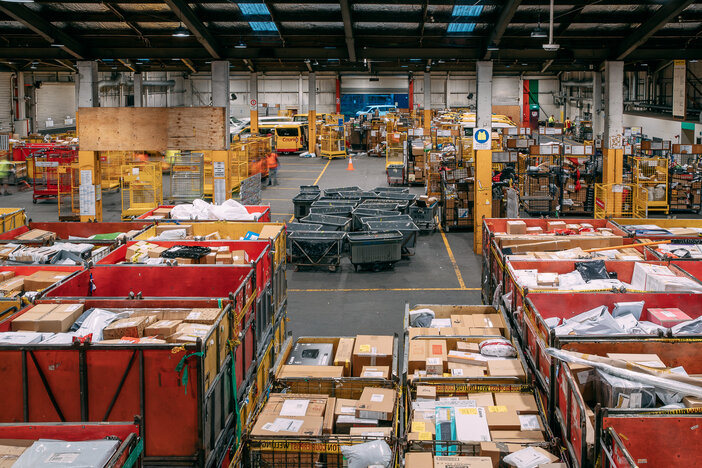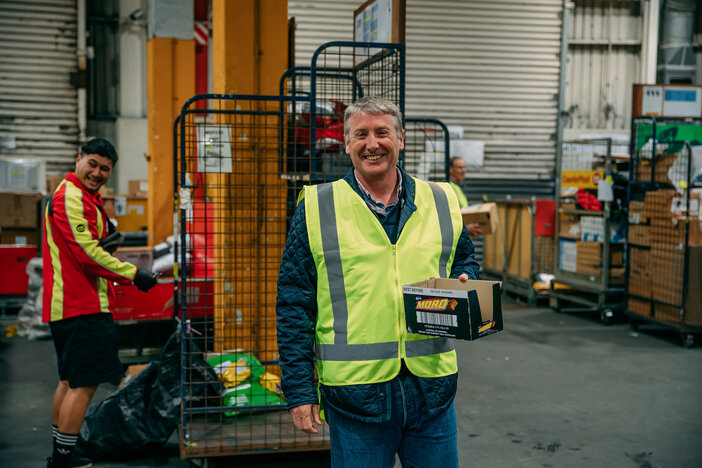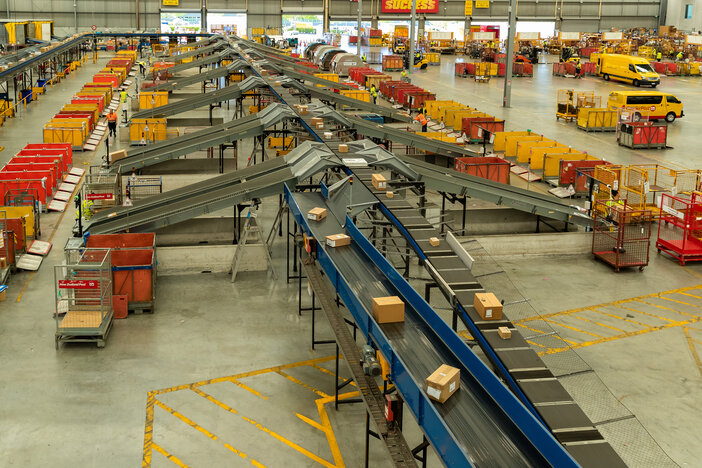David Walsh had a good Christmas. The New Zealand Post CEO likes to get around the network and talk to his people. Over the festive peak, they were far more composed than they had been back in April, when successive Covid regimes created a perfect storm for the organization, unleashing pent-up demand and flooding its network with 3.5 million parcels in two weeks. Walsh was front and center, defending 10-day delays to next-day deliveries on the evening news. The lessons learned enabled a more fluent Christmas performance and will inform a NZ$170m (US$122m) investment in NZ Post’s processing backbone, which Walsh considers essential in equipping the business to handle the tides of a changing world.
“Traditional posts must be as nimble as major players like Alibaba, Amazon and Aramex and keep pace with global expectations,” Walsh says. “Otherwise, we risk losing relevance.”
NZ Post is a state-owned enterprise serving an island nation of 5.1 million. In 2019, its letter volume fell 18% year-on-year, but it delivered 80 million parcels and 50% of New Zealand’s online shopping. “As postal rates come closer to commercial rates, global players will have greater parity,” Walsh continues. “The last mile continues to evolve, with digitally enabled options and the ‘Uberization’ of deliveries. We must embrace those capabilities as we deal with letter decline and surges in volume.”
The post has certain advantages: regulatory flexibility, close community ties and renewed clarity of purpose. “Our purpose is to deliver what people care about,” continues Walsh. “Our goal is to be New Zealand’s best delivery business.”
In 1840, New Zealand’s first post office was founded at Kororareka and its first postmaster was suspended for ‘continual inebriety’ shortly after. By 1900 the post office network had 1,700 branches and over the next century delivered services including registration of births and deaths, voter enrollment and even wedding ceremonies. It was corporatized in 1989 with three core aims: to be commercially profitable, socially responsible and a good employer. “Legacy organizations have both the advantage and the tyranny of history,” Walsh observes. “We’ve been around for 180 years. There’s quite a responsibility, considering what’s in front of us.”

E-commerce spike
Thanks to early government action, Covid claimed just 25 New Zealand lives in 2020. March saw a national Level 4 lockdown with deliveries restricted to essential items only. “Volumes just hit the wall: everything stopped,” Walsh recalls. “We remained an essential service and had to ensure our people could operate safely.” Imports and exports account for one-third of normal volumes, making grounded air traffic a major problem. “We rely on airline belly-space,” he says.
“We went from around 800 to 150 international air connections. We started doing our own charters. We were flying products from Europe to Singapore then sea shipping them to New Zealand.” But transition from Level 4 lockdown to Alert Level 3 made April the cruelest month.
“We got absolutely smashed,” Walsh admits. “Suddenly, the gates opened on restricted deliveries and we had 100% volume spikes.” Whereas NZ Post prides itself on a 97% next-day parcel delivery rate, parcels were taking 7-10 days to arrive. “We’re a flowing network and don’t often store stuff,” Walsh explains. “It comes in then gets processed, transported and delivered. We’re constrained in the volume that we can process.” Crucially, it was in the last mile that NZ Post was overwhelmed by the unprecedented parcel tsunami. “Our processing centers started to deal with the input volumes, but our delivery depots couldn’t cope with the volume pushed into them,” he continues. “Our van efficiency completely fell over.”
As Walsh fielded tough questions on television, NZ Post scrambled to scale up its networks. “We created temporary sites to manage staging of products into delivery cycles,” he says. “We moved quickly to bring in temporary drivers so we could flush our depots. We did weekend pickups and 24-hour processing.” NZ Post was quick to engage with its largest sending customers. “We communicated every day about network status, transport, last-mile delivery and data quality,” Walsh explains. “That enabled them to manage buyers’ delivery expectations on their websites.” When the storm eventually passed, NZ Post commissioned an independent review and swiftly implemented its recommendations. “Covid was a shock to the system but also an opportunity to carry learning forward,” he says.
E-commerce had been relatively embryonic in New Zealand. In 2017, just 7% of shopping happened online, compared with 16% in the UK. Lack of solid research prompted NZ Post to commission The Full Download, a comprehensive report on the subject. “We’re starting to forward lead, and the media come to us now with questions,” says Walsh. “Around Covid, online buying increased by 100-120%. Although that level hasn’t held, we’ve seen about 30% year-on-year growth and noticed seniors getting more confident buying online.” In November 2020, Kiwis spent NZ$585m (US$419.6m) online, 27% up on 2019, including NZ$115m (US$82.5m) across Black Friday and Cyber Monday, when NZ Post received 300 parcels per minute. “Black Friday has become a signal of what the peak will look like,” says Walsh.

Ambition and investment
NZ Post will spend NZ$170m (US$122m) on its network in the next three years. It will create the robust backbone needed to manage rising parcel volumes and cope with unexpected surges, including a new Wellington super depot. “The second part of that investment path is about data quality,” says Walsh. “Getting the injection standards and quality of information on the label, through the sort machines, will improve our service quality and delivery accuracy.” It means working with large sending customers – e-commerce platforms – to ensure consistency in the information provided via APIs.
“Standard data integrity means we can provide better information on delivery timescales, contents and product quality,” he continues. “That will flow into decisions on buying optical reading equipment and how sort sequencing works from there.” Walsh sees this work as essential in enabling NZ Post to match the service of global competitors. “In organizations like DHL or DPD, data standards integrity, optical reading and addressing standards and item standards are critical. Everyone injecting into your network must have those standards together. We just have to make sure that’s our benchmark,” he says.
Lessons learned in April resulted in a more orderly Christmas. “Every year volumes increase, and the shoulders get wider, but we came through incredibly well,” says Walsh. Improved planning for capacity, new ways of processing, better connections between transportation and depots, and communication with retailers to manage network inflows all played a part.
“People were busy, but it was controlled,” he reports. “You could see them saying ‘I’ve got this, I know what’s coming’.” The main challenge was international, since the inability to travel prompted a spike in overseas gifting.
Perhaps it is coincidence that Walsh began his career in the mailroom of Shell Oil, as change has been the only constant in the intervening years. He joined TransAlta during the deregulation of New Zealand’s electricity sector and ended up a youthful acting CFO. He worked for Fonterra during its consolidation
of New Zealand’s dairy industry, experienced deregulation again at New Zealand’s Racing Board then moved to KiwiRail before joining NZ Post in 2015. “My experience has been large-scale organizations going through change,” he reflects. “They all involved a physical network. Moving parcels is physical – and
the parcel is what people want. The digital part is about communication and user experience. Linking the two is what’s interesting.”

Walsh seems a likeable boss and takes NZ Post’s obligation to be a good employer seriously. “We directly employ about 4,500 people and have another 1,500 contract drivers,” he says. “Our posties are well regarded and people resonate with the role they play. It’s important that we pay fairly, provide opportunities for people to develop their careers and be themselves in our organization.” NZ Post has a Rainbow Tick for embracing sexual and gender difference and is committed to a workforce that reflects New Zealand’s ethnic diversity. But more than that, Walsh cares what happens to people. “We have a responsibility, as we navigate a massive pivot-point for our business, to support our people and bring them with us,” he says. “That’s what motivates me to get up in the morning.
“We’ve got ambitious plans, but we have to execute them and do it well,” he concludes. “You can have
the best-laid plans, but it’s a question of holding the course. The role postal organizations have played in connecting people gives them a great opportunity to be part of the forward evolution. But if we don’t deliver, others will fill that space.”
This article was originally published in the April 2021 issue of Parcel and Postal Technology International.


